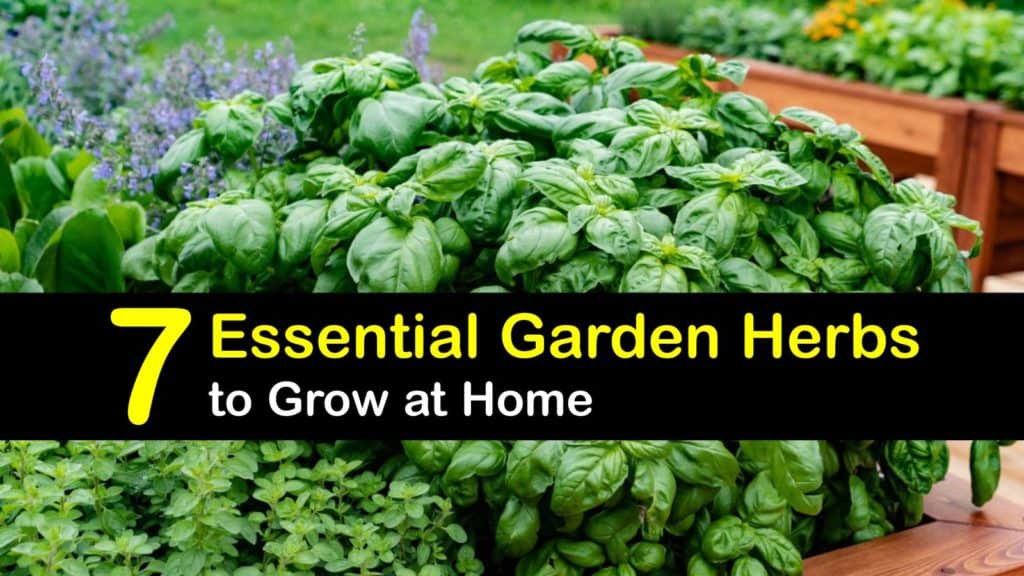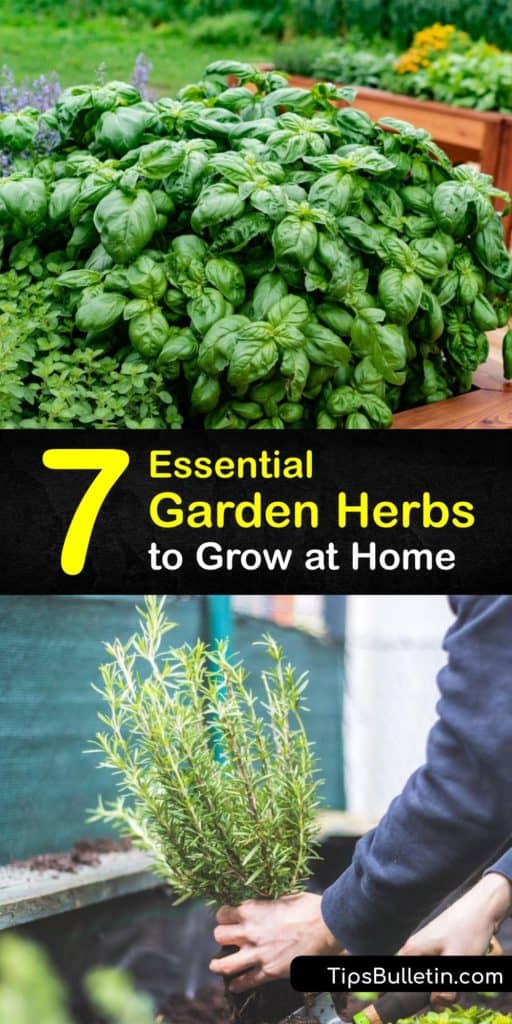Most people don’t realize how easy an herb garden is to take care of, but they don’t always know where to start. Fresh herbs are crucial to making a dish stand out and giving it a more in-depth flavor. We have compiled a short plant list of the best herbs to grow in your garden to make your at-home cooking taste even better.
The biggest thing holding people back from growing garden herbs is that they think it takes too much time and dedication. How long do herbs take to grow? How much of your time do you have to spend tending to their needs?
You are mistaken if you think herb plants are anything other than easy to grow. Their green leaves flourish in a short amount of time. With a little bit of light and water, you’ll be picking fresh greens from throughout the whole year.

Prep for Growing Garden Herbs
There are several places where people successfully grow herbs. The best herbs to grow in your garden either thrive in a kitchen garden or traditional outdoor vegetable garden spaces.
Container gardening or raised beds also work. We find that any culinary herb makes a great addition to the kitchen because you simply snip a few sprigs off and get right to work rather than going all the way outside.
Almost all of these plants are year-round herbs that do well with full sun or partial shade from a windowsill with well-draining potting soil and water. Herbs to plant in winter include almost everything if you grow them indoors.
However, these herbs enjoy spreading out and might benefit from a container with about one foot of room to expand. The way to grow herbs in containers is the same as growing them in the garden.
The most important aspect of finding the best herbs to grow in your garden is ensuring that they have a suitable location. Determine the best time to plant herbs depending on which ones you want to grow. Place the herbs in a spot that receives at least four hours of sun during the day, or place them under a grow light.
Make sure you use fertile and moist soil. When planting herbs in pots or in the garden, add compost to improve drainage and add nutrients.
When planting in containers, find a pot at least eight inches in diameter for each plant. You might have to transplant them into larger containers as they grow.

Drill in several drainage holes to allow the dirt to fully dry out between watering sessions. Once the basic care requirements are completed, your herbs will start providing you with flavorful greens to use as a garnish or enhance your food’s flavoring.
How Long do Herbs Take to Grow?
We know that you’re excited to get started. Patience is a crucial characteristic to have when growing all sorts of plants. How long do herbs take to grow? It usually takes two to four weeks for the seeds to germinate when the soil temperature is at least 70°F.
Some types of herbs grow faster or slower, but this is a safe timeline. After they germinate, it will be another week or two before you start to snip off the stems and stir them into your meals.
The Best Herbs to Grow in Your Garden at Home
If someone wrote an expansive list of every possible herb you could grow at home, it would be overwhelming. Where do you start? The best herbs are ones with flavors that are good for a variety of cuisines and recipes.
You also benefit most when you choose herbs that you’re already buying from the store on a regular basis. This list has some common garden herbs that are easy to grow and have various uses in the kitchen.
As a bonus, the best way to repel mosquitoes outside is to grow plants and herbs they find distasteful. Lemon balm and citronella are just a couple of examples.
Parsley
Parsley is a biennial plant. It falls under either the flat-leaf or curly parsley categories. These popular herbs have similar flavor profiles with only slight differences.
Flat leaf parsley has longer, flatter leaves and a more robust flavor. Curly parsley is more often used as a garnish with tighter, frillier leaves. It also tastes a little more bitter.
Some of the most popular cultivars are Chervil and Italian parsley. Italian parsley is one of the most common and used for its bold flavors that go well with steak, soup, pasta, and more.
Parsley is a little slow to germinate compared to other herbs. Soak the seeds overnight to speed up the process before sowing them. They like to be six to eight inches apart with a soil pH of 5.5 to 6.7.
Keep the soil consistently moist and harvest them by snipping off the stems at the base when they reach the size you like. Don’t snip off more than one-third of the plant at a time.
Use a food processor to finely chop the garlic, chives, parsley, and oregano and set them aside in a small bowl. Stir the olive oil, vinegar, red pepper, salt, and black pepper into the leaves.
Taste and adjust the level of salt and pepper before serving it immediately or putting it in the fridge to chill.
Don’t substitute cilantro for parsley. There is a big difference between parsley and cilantro regarding flavor.
Oregano
Oregano is another fantastic herb to grow in your personal garden because it goes well with many different things. Marinate it with chicken and lemon juice for a quick lunch, or stir it into your favorite Italian dishes to give them a fresher flavor.
Warm and sunny locations are best for growing oregano plants. Keep the plants eight to ten inches apart from one another and mix in some aged compost to keep the soil fertile. Water them whenever the top inch of dirt is dry.
Harvest oregano by snipping off individual sprigs that are at least three to four inches tall. It has its best flavor right before it blooms. Dry the oregano in a dehydrator and store the leaves for up to a year in a dark cupboard.
Mint
It’s hard not to become slightly addicted to the crispy, unique taste of fresh mint. There are a lot of different types, with spearmint and peppermint being the most popular. Incorporate mint into a dessert or toss leaves into a glass of iced tea for a refreshing taste.
Growing mint from the seed isn’t as common as using a parent plant from a garden center. Mint is a fast spreader and is often one of the herbs that are perennials, coming back year after year. Plant them in pots to keep the roots contained and stop them from taking over your other herb plants.
Give them full sun or partial shade. They tolerate all soil types and, although they like well-draining soil, they will do fine if it doesn’t have enough.
Coriander and Cilantro
Although they have different names, these two herbs come from the same plant and have similar flavor profiles. Coriander refers to the plant seeds, and cilantro refers to the leaves and stems.
How far apart to plant cilantro, the type of soil and the amounts of water and sun are all important considerations if you grow this plant yourself.
You often find these herbs used in Mexican cuisine. However, we enjoy them when made into a pesto sauce and mixed with pasta.
Drop all of the ingredients except the oil into a food processor and process them until finely chopped. Keep the motor running, and slowly drizzle in the olive oil until you reach a consistency you like.
Fennel
Fennel is a popular Mediterranean herb, and it is usually paired with salads and fish dishes. Growing fennel from seed is easy. It has bright yellow flowers, and the fringe-like leaves have a similar flavor to anise.
This herb is best grown outdoors because it is a favorite for essential pollinators. It is one of the best herbs for fall, as you can harvest the leaves in the spring or fall as often as you like.
Marjoram
Marjoram isn’t the most used herb, but it has a bold flavor and fragrance that packs a punch to whatever you’re cooking. It is often used as a garnish for salad, soups, and all types of meat dishes.
It also aids in digestion and helps keep your body working correctly. Only water the plants occasionally. They tolerate drought, and too much water may drown them.
Tarragon
Tarragon isn’t the most conventionally attractive plant, but we think it is one of the best herbs to grow in your garden. The long thin leaves are aromatic and add a peppery flavor to foods.
People love to add this herb to a vinaigrette with brighter herbs, like lemon balm, for an amazing salad dressing. It is easiest to sow tarragon seeds just before the last frost of spring.
Harvest the leaves and flowers of this plant in the late summer and keep them frozen or dried for extra-long storage.
Growing garden herbs is beneficial to those who love to cook and use homegrown, pesticide-free plants. Once you start this fun hobby, you’ll reap the benefits only a few weeks after most of the hard work is over.
These fresh herbs are a great place to start if this is your first time growing an herb garden because they don’t require too much time or attention.

If this list of the best herbs to grow in your garden has made your family appreciate your home cooked meals, share this simple guide to growing garden herbs on Facebook and Pinterest.